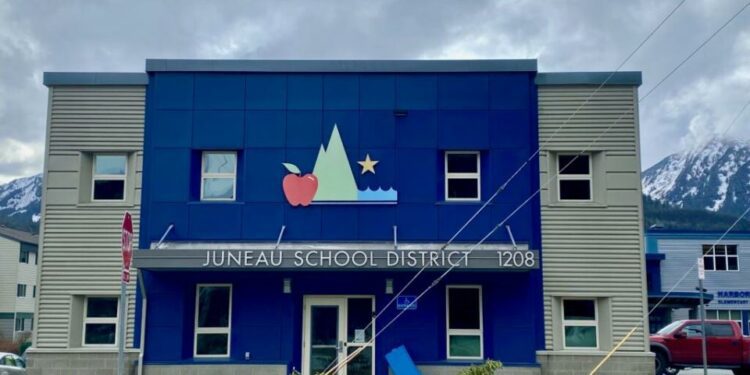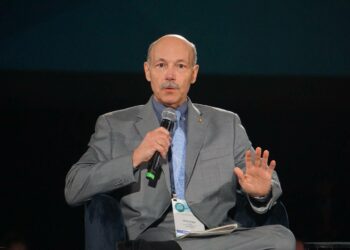This article was originally published in Alaska Beacon.
Laurie Duncan got her pink slip at the end of April, after her second year teaching first grade at Xóots Elementary in Sitka. She got the news during her prep period. She was three months pregnant.
Nearly 20% of the teachers in Sitka were laid off this spring due to financial uncertainty. That included all of the district’s librarians and most of its reading specialists.
“I can’t really necessarily get a new job, because I’m about to go on maternity leave in August and have a baby,” she said, then laughed. “I’m kind of in a bind. This baby’s coming, and I can’t not have the baby anymore!”
Get stories like these delivered straight to your inbox. Sign up for The 74 Newsletter
Duncan has a master’s degree in teaching and plans to stay and raise a family in Sitka, where her husband is from. She had a plan for a long-term substitute teacher for the two months after she delivered. Instead, she lost her health care at the end of May. She didn’t find out she got a job back until July.
She, and a number of other laid-off teachers got rehired recently after Gov. Mike Dunleavy signed into law the Legislature’s one-time, $680 increase to the per pupil funding formula. The boost came after districts painted a desperate picture of their finances during the legislative session and Dunleavy vetoed lawmakers’ attempt to make a significant, long-term increase to the school funding formula. He said it lacked his priorities for education, like bonuses for teachers, more options for charter school approvals and changes to reading education. Lawmakers didn’t override the governor’s veto by one vote.
Districts statewide say the one-time increase helps their finances and allows them to bring back some of the teachers they laid off, but in many cases the news has come too late. Many school boards had already opted for conservative budgets, fearing Dunleavy would veto the one-time funding as he did last year. Some teachers left their districts and communities to seek more stable work.
Duncan said several of her colleagues moved on because they couldn’t risk being out of work.
“You have to make choices for your family, and that’s a big bummer, because we’re losing fantastic teachers,” she said.
The state is unlikely to regain them all, even as officials invest in studies and working groups to solve a recruitment and retention crisis that meant the state’s public schools started last year with nearly 400 unfilled teaching positions.
Some teachers move on, or resign
The Ketchikan district laid off more than 50 teachers — roughly a third of its staff — before adding many jobs back on the gamble that Dunleavy would allow most of the Legislature’s one-time funding to stand.
Jill Nordtvedt Lenhard and her husband were both teachers there until they got their pink slips in early May. She said their health insurance was slated to be cut off at the end of June, and they have an autistic son they needed to think about.
“We had some really big decisions to make,” she said.
Lenhard took a job teaching English in Petersburg where she had worked for roughly two decades. It came with a substantial pay cut because the district only puts 10 years of experience towards the salary scale for rehires. And since her husband, who was tenured in Ketchikan was among the teachers hired back, they will be living apart for the next year.
“The governor’s decision to veto that education funding back in March had such wide-ranging impacts on school districts and teachers and administrators and students around the state,” she said. “But it’s personally created a pretty difficult situation for my family.”
A spokesperson for Dunleavy’s office said the governor is “acutely aware” of what districts need to function and that the governor has supported hundreds of millions of dollars in education funding.
“He believes school districts need more resources, but if they are having issues accounting for their money and/or they’re having fewer students going into schools, we need to have a discussion,” wrote Deputy Press Secretary Grant Robinson in a statement.
Sarah Campbell has taught in the district for 20 years and is the president of the teacher’s union there. She said the district lost a “master teacher” in Lenhard.
“I’ve never ever seen such a disruptive and chaotic end to the school year,” she said in June. “Teachers are in tears. We’re cutting preschool. We’re cutting — we still don’t have activities funded for next year.”
In August, after the one-time funding increase survived the veto process and almost all teachers got called back, she reflected on the cost of the upheaval.
“The only reason our district was able to recall all of the teachers back is because we had probably, like, 12 resignations,” Campbell said. “So because the layoffs happened and we had people kind of panic, and they’re like, ‘I can’t not have a job next year; I must have a job.’”
The scramble to restaff schools is really disruptive to the overall educational program, she said. The district cut its information technology director and curriculum director, and eliminated all the elementary school counselors. Many teachers are going back to new jobs at different schools.
“While people may have been recalled back for jobs within our school district, they’re teaching at different schools, different grade levels and potentially different subject matter. So essentially, they’ll be starting all the way over here; it’s like having to rebuild something from scratch,” she said.
Campbell said it’s been a stressful time, and said because lawmakers approved only one time funding, “We are going to be in the same exact situation this upcoming school year.”
Michael Robbins, the district’s superintendent, confirmed the district lost about a dozen teachers to other jobs and said consistent funding allows districts to create consistent teacher contracts.
“They’re professionals. They put a lot of time and effort into being a teacher, and they should have that consistency, knowing that they’re going to have a job and that they’re going to be able to work in a community that they want to,” he said.
The yo-yo of layoff and hire-backs may be counterintuitive against the backdrop of a serious teacher shortage in the state and the nation. Alaska’s university system does not produce enough teachers to fill the teaching position job openings each year, so Alaska must compete with the Lower 48. Some districts hire international teachers or use emergency contracts to staff their classrooms.
Other districts are feeling the turbulence, too.
Anchorage Education Association President Cory Aist has raised the alarm about teachers leaving the Anchorage School District. By the union president’s count, nearly 400 teachers resigned in the last school year from the district alone. The district’s recent average is 200-300 teachers a year, but that number has been increasing.
“Our educators are looking for exit strategies,” he said in testimony to lawmakers in February.
In the Juneau School District, more than three dozen teachers resigned in an eight-week period this spring, school board member Will Muldoon said in June. The district planned to lay off nearly 50 teachers, but was also able to bring dozens of positions back after Dunleavy signed the budget without vetoing any of the one-time funding for districts. In Juneau that ended up being roughly $5.2 million.

The Juneau School District administration building is seen on April 4. (Claire Stremple/Alaska Beacon)
Juneau Superintendent Frank Hauser said that, ultimately, the district laid off about four teachers, but that number is only so low because of the teachers who resigned or retired.
In Sitka, the layoffs could have been more extreme, but the district planned to spend down its budget reserve to $10,000 in order to keep teachers and what remains of programs like art, music and physical education.
“We had to cut most of our non-tenured teachers,” said Superintendent Deidre Johnson, in an email. Fourteen were laid off, 15 transferred within the district. One retired. Five just left.
Mike Vieira, a lifelong Sitkan and a teacher of more than two decades, said both his daughters’ teachers got layoff notices.
“Our district has never seen anything like this,” he said in June.
In July, the principal at the high school where he teaches resigned for a job in Washington state. The Spanish teacher has more than 35 kids in her class: “Her desks are wall to wall,” he said.
“This is going to be a challenging year all around because of what our new reality is,” Vieira said.
The district planned its budget around a $500 per pupil one-time increase in state funding — a good guess, considering the $680 per pupil increase in its budget for the next fiscal year. The one-time funding meant it could hire back four teachers, including Duncan, and build back some depleted funds.
Fairbanks North Star Borough School District Superintendent Luke Meinert said funding uncertainty meant schools had a hard time gauging how much staff they could afford. And since districts haven’t had a significant funding increase in nearly a decade, he said schools don’t want to gamble on overstaffing because they lack the financial cushion.
“For us here in Fairbanks, we had a pretty conservative proposed budget that had sizable cuts to not only staff, but programs within the district,” he said.
“This has been a repeated cycle for almost a decade in Alaska, it seems like, but definitely getting worse. And when that happens, we oftentimes lose really great teachers and qualified teachers that we would love to keep in Fairbanks.”
He said that is compounded by the fact that it is harder to hire teachers now. Also, Fairbanks is a military community, which can contribute to turnover. This year, the district’s elementary schools are starting the year 20 teachers short — a high, according to Meinert.
Sen. Jesse Bjorkman, R-Nikiski, has taught in Alaska for 15 years and is a member of the Senate Education Committee. He said there’s been significant turnover in the Kenai Peninsula Borough School District for quite awhile, partly because the pay and benefits lag behind the rest of the country, but also because of increasing job instability.
“With pink slips being issued year after a year, people just don’t have the certainty that they need to feel comfortable to remain in Alaska,” he said.
“When someone gets notice that they might not have a job in the late winter or early spring, and there’s not resolution to that question until the end of June or early July, that’s a problem.”
For his part, Rep. Ben Carpenter, R-Nikiski and Bjorkman’s opponent, said he recognizes the timing issue — that’s why he and other members of the House tried to pass the education bill early. He supported Dunleavy’s veto of a permanent increase and said a root cause of funding issues is declining student enrollment:
“If we would address those root causes, then some of the funding, the BSA formula funding problem would be less of a problem.”
Carpenter said he would like to see education reform, including more parent involvement in classrooms. “There’s more to it than just the dollar figures,” he said.
Bjorkman is not teaching this fall to focus on politics. He said his former colleagues are seeing a decline of personal opportunity as well as feeling burnout from large class sizes, as schools grapple with not having enough staff.
“It seems like, more and more, people that can get out or move on want to do something else — they’re taking action on those desires. It’s not just a thought, or talk. It’s: ‘Nope. I’m doing this,’” he said.
That was the case for Jenell Hartman, an Anchorage School District health specialist until this May, who said this kind of turmoil was a constant. Her positions were often grant funded; one of the schools she taught in was threatened with closure. She said the straw that broke her as an educator was when the district, seeking financial relief, decided briefly to cut art and health programs from elementary schools.
“There’s never been a level of stability I felt like in the state of Alaska, being an educator here,” she said.
“It’s untenable, and it causes that stress, and it causes this extra layer of: ‘What am I doing with my career?’”
She said she is unlikely to return to teaching, in part because she said the job doesn’t provide a secure retirement plan for Tier 3 employees. Hartman is from Anchorage, so she stayed in state and took a job with the state’s teacher union — advocating for teachers instead of being one.
“To work with kids is a special calling. So I would love to see folks stay and have really good, professional teachers up here and give our kids what they deserve, but also have a dignified salary and retirement that they deserve as well,” she said.
“That’s kind of my hope after leaving the classroom. That’s my hope for the future.”
Alaska Beacon is part of States Newsroom, a nonprofit news network supported by grants and a coalition of donors as a 501c(3) public charity. Alaska Beacon maintains editorial independence. Contact Editor Andrew Kitchenman for questions: [email protected]. Follow Alaska Beacon on Facebook and X.
Source link : http://www.bing.com/news/apiclick.aspx?ref=FexRss&aid=&tid=66bffd8fc4a84c64b8bb650e326f3940&url=https%3A%2F%2Fwww.yahoo.com%2Fnews%2Falaska-schools-got-one-time-163000858.html&c=9496194649179913154&mkt=en-us
Author :
Publish date : 2024-08-16 05:30:00
Copyright for syndicated content belongs to the linked Source.






